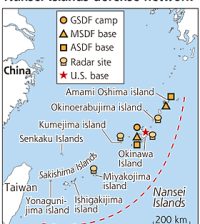- Washington “follows with interest” Morocco’s openness onto Africa (John Kerry)Posted 12 years ago
- The trial of South African Paralympic champion Oscar Pistorius opened in Pretoria on Monday.Posted 12 years ago
- USA welcomes efforts of King Mohammed VI in MaliPosted 12 years ago
- Egypt’s population reaches 94 millionPosted 12 years ago
- Mugabe celebrates his 90thPosted 12 years ago
- Moroccan Monarch to Build a Perinatal Clinic in BamakoPosted 12 years ago
- King Mohammed VI handed a donation of bovine semen for the benefit of Malian breeders.Posted 12 years ago
- Moroccan King’s strategic tour to Africa: Strengthening the will of pan African Solidarity and stimulating the south-south cooperation mechanisms over the continentPosted 13 years ago
- Senior al-Qaida leader killed in AlgeriaPosted 13 years ago
- Libya: The trial of former Prime Minister al-Baghdadi AliPosted 13 years ago
Japan’s Political Landscape Shifts as LDP and Japan Innovation Party Begin Coalition Talks
By R. ELM . Tokyo, October 16, 2025-
Japan’s ruling Liberal Democratic Party (LDP) and the Japan Innovation Party (Nippon Ishin no Kai) are set to begin formal policy consultations this week in a move that could reshape the country’s political balance. The talks aim to explore possible electoral cooperation and lay the groundwork for a new coalition government – a significant development following the recent breakup of the LDP’s 26-year alliance with Komeito.
The LDP and the Japan Innovation Party agreed to open a policy dialogue on Wednesday during a meeting in Tokyo between their respective leaders, Sanae Takaichi and Hirofumi Yoshimura.
Yoshimura stated that if policy terms can be agreed upon, his party would consider supporting Takaichi’s candidacy for prime minister in the upcoming parliamentary vote.
Should the two parties align, their combined strength – 231 seats in the 465-member lower house – would leave them just two seats shy of an outright majority. Such an alliance would significantly bolster Takaichi’s prospects of becoming Japan’s first female prime minister, following the resignation announcement of Prime Minister Shigeru Ishiba on September 7.
However, the prospective coalition’s narrow margin – roughly 51 percent to 49 percent – would leave the incoming government with limited room for maneuver. Passing primary legislation could prove difficult without support from smaller opposition blocs, likely compelling the new administration to adopt a more consultative approach and maintain dialogue across party lines.
Some political analysts argue that the LDP should keep communication channels open with Komeito, its long-time partner, despite the current split. Continued coordination could provide the stability and legislative flexibility needed to ensure smoother policymaking under a potential Takaichi-led cabinet.
Policy Convergence and Negotiation Points
The policy dialogue, scheduled to begin Thursday, will bring together senior leaders and policy chiefs from both parties. Key topics on the agenda include:
- Social-security reform amid Japan’s aging population;
- Political-fundraising transparency; and
- Regional development, particularly in Japan
Innovation Party’s flagship proposal to designate Osaka as a “second capital” alongside Tokyo is a long-standing symbol of its regionalist and decentralization platform.
Yoshimura emphasized that any cooperation must be based on shared principles rather than short-term expediency, suggesting that both parties seek a policy-driven alignment rather than a purely numerical one.
Uncertain Parliamentary Dynamics
Japan’s political environment remains fluid following Komeito’s decision to end its decades-long partnership with the LDP – a rare moment of volatility in a system long characterized by stability. No single party or bloc currently commands a majority, and the identity of the next prime minister remains uncertain.
An extraordinary Diet session is set to convene on October 21, though the exact timing of the leadership vote has yet to be finalized. The LDP initially proposed holding the prime-ministerial election the same day, but opposition parties have objected, citing ongoing coalition talks.
Once a new prime minister is elected – through votes in both chambers, with the lower house decision prevailing in case of a split – a new cabinet will be immediately formed and formally appointed by the emperor.
The incoming government will face a demanding diplomatic calendar, including the ASEAN Summit in Kuala Lumpur on October 26 and a scheduled visit to Japan by U.S. President Donald Trump shortly thereafter.
Opposition Efforts to Forge an Alternative Bloc
Meanwhile, opposition parties are exploring their own options. Leaders from the Constitutional Democratic Party of Japan (CDP), the Democratic Party for the People (DPFP), and the Japan Innovation Party met in the Diet on Wednesday to discuss potential collaboration.
CDP leader Yoshihiko Noda urged a bolder strategy aimed at unseating the LDP altogether. “Rather than negotiating to implement a few shared policies, it would be more effective to take power to move things forward,” Noda told reporters.
However, DPFP leader Yuichiro Tamaki voiced caution, noting that even a united opposition front might still fall short of a majority. “Frankly, that framework still feels weak,” Tamaki said, stressing the importance of stable governance and policy coherence. He also pointed to lingering differences over national security and nuclear energy, areas where the DPFP’s positions remain closer to the LDP than to the left-leaning CDP.
Tamaki and Noda agreed to continue discussions, with another meeting of party leaders expected early next week.
Alongside her talks with Yoshimura, Takaichi also met separately with opposition leaders Noda and Tamaki, underscoring shared policy interests – notably economic revitalization through technological innovation. “Both our parties share the belief that Japan’s growth should be driven by turning scientific and technological potential into tangible societal benefits,” she said after the meeting.
Takaichi’s emphasis on continuity, innovation, and economic security has positioned her as the leading contender to succeed Ishiba. However, her success will depend heavily on the LDP’s ability to secure dependable coalition partners.
A Test for Japan’s Political Stability
The unfolding negotiations mark one of the most consequential political transitions Japan has seen in over a decade. With coalition lines redrawn and ideological boundaries increasingly blurred, both ruling and opposition blocs face mounting pressure to demonstrate stability ahead of what could be a turbulent period in Japanese governance.
Whether through a new LDP–Innovation alliance or an alternative opposition coalition, the upcoming weeks will likely determine not only Japan’s next leader but also the future shape of its political landscape for years to come.
In the view of many experts, the country today needs more than at any time in recent decades — a stable political leadership capable of remaining in power for longer than three years. Only such continuity would allow Japan to implement its medium-term reform agenda effectively.
This stability is considered crucial strategically in two main areas. Firstly, it allows for steady advancements in social and health policies, helping to maintain welfare systems amid a declining population. Secondly, it offers the long-term perspective necessary to propel Japan’s technological evolution, strengthening its leadership in fields like space exploration and artificial intelligence.
At the same time, experts stress that a durable government is required to reassess Japan’s security and defense posture, as global and regional power shifts accelerate. From the Indo-Pacific to Europe, changing geopolitical dynamics demand strategic foresight and coherent policy execution — something only a politically resilient administration can deliver.




